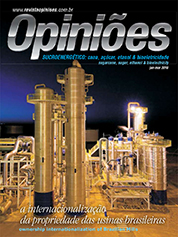Eduardo Pereira de Carvalho
Director of Expressão
Op-AA-23
The internationalization of sugar and ethanol production means in Brazil
Nowadays, foreign capital is increasingly present in the industry. That is nothing new. In the 478-year history of sugarcane in the country, this happened often before. Without looking back too far, I remember the presence of Dreyfus since 2000, followed by the entry of Tereos, the initial steps of Cargill, the important initiatives of ADM, Bunge, BP, Nobel, Abengoa, George Soros, the Indians and others, in the recent past.
And also the international financial system, in the pre-crisis period, identifying and supporting almost a dozen investment projects in the industry, of which not all have, for the time being, become success stories. In parallel, large amounts of Brazilian capital were also earmarked for investment in the industry. The important presence of Cosan (with its spectacular move involving Shell), São Martinho and Guarani, in the capital market, finishes off the current scenario, in addition to the pre-announced nationalization of Brenco by ETH.
This matter involves, apart from economic reasons, a number of political issues. I will not address them here. The country is undoubtedly one of the biggest beneficiaries of direct foreign investments in just about all areas and industries of the economy, enjoying a variety of benefits. Why is this not so in the areas of ethanol and sugar? In the last 30 years we built – considering the 100 million tons of sugarcane crushed at the end of the seventies, to the practically 600 million tons processed in the past harvest – the most efficient, dynamic and innovative plantation and industrial transformation apparatus of sugar and ethanol of which the world had ever heard.
Until a few years ago, the combination of “native” entrepreneurship (at times with an Italian accent), with incisive governmental support, was capable of creating all this wealth. Not any more. Why? Insufficient EBITDA, cash generation, generation of surplus. Investment volumes and the nature of operations have become highly capital intensive, both in the agricultural and industrial phases.
The required volume of funds for continuous expansion – in the world of commodities an essential survival factor – grew as never before thought possible. A normal cash flow from activities, even in years with unfavorable economic scenarios, no longer allows self-financing of their growth, even when resorting to the use of modern credit, financing and trade leveraging tools.
What is needed is the injection of new foreign capital, given that a large number of current mill owners have all their equity (and at times even a lot more) tied up in current operations. Hence, the strong economic need for new foreign funds. Let us be quite clear about this: these are external funds, whether from abroad or from the local capital market, or other sectors of the economy. But it is not the only reason.
Such capital is often associated with new technologies, new governance models, new management models, new markets. It brings about cross-fertilization. We all can see the fantastic potential results. Continuous improvement of performance, efficiency, innovation and the subsequently resulting waves of renovation. This is not about replacing the current entrepreneurs.
They continue playing a relevant role. The industry will continue in a decentralized state, regardless of how big or fast the concentration process will be. There is something inherent in the activity that allows the survival of isolated units of smaller relative size. The degree of management excellence is what stands out. Land quality is extraordinary.
The integration of the agricultural and industrial parts stands as a reference model. The technological level, especially in agriculture – which is more difficult to manage than the industrial part – is first class, in which the level of capitalization – an essential aspect – is adequate. However, nothing will prevent the continuity of the concentration process, for all the reasons mentioned.
Foreign investments are an integral part of this scenario. As Darwin would say, with extraordinary wisdom, the most apt will survive, or rather, those best equipped to adapt to new circumstances. The industry stands out for its huge resilience. One should observe, however, that foreign capital in itself is no insurance policy against presumptuousness, bankruptcies, poor management and low performance. It suffices to look around. Without this consolidation, the so poorly performed distribution of ethanol – one of our major problems given the decentralization of production – will continue being an important obstacle for the industry’s full development.




